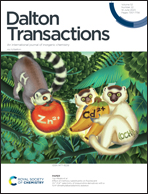Donor–acceptor bridge 2,5-bis(2-oxido-phenyl)thiazolo-[5,4-d]thiazole derived diruthenium and diosmium systems. Structural and competitive electronic events as a function of metal ion, bridge and ancillary ligand†
Abstract
The article deals with the structural and electronic forms of hitherto unexplored L2− (H2L = 2,5-bis(2-hydroxyphenyl)thiazolo-[5,4-d]thiazole) bridged analogous diruthenium [{(AL1/AL2)2 RuII}2(μ-L2−)]2+ [1](ClO4)2/[2](ClO4)2 and diosmium [{(AL1/AL2)2OsII}2(μ-L2−)]2+ [3](PF6)2/[4](ClO4)2 complexes as a function of moderate-to-strongly π-accepting ancillary ligands: AL1 = 2,2′-bipyridine (bpy) and AL2 = 2-phenylazopyridine (pap). Structural elucidation of the complexes established an anti-oriented bridge (L2−) linked to the metal units through its N,O−/O−,N-donor sets, which led to two six-membered chelates in each case. It also highlighted the twisting of the phenolato functions of L2− with respect to the central thiazolothiazole (TzTz) unit and the unreduced state of the azo function of AL2 and multiple non-covalent π⋯π/CH⋯π interactions within the molecules in the nearby asymmetric units. The potential of the multiple redox steps of the complexes varied as a function of Ru versus Os and AL1 versus AL2. A collective consideration of experimental and DFT calculations revealed largely bridge- and metal-based first and second oxidative steps, which could be attributed to the electronic forms [(AL1/AL2)2MII(μ-L˙−)MII(AL1/AL2)2]3+ ↔ [(AL1/AL2)2MII(μ-L2−) MIII(AL1/AL2)2]3+ and [(AL1/AL2)2M2.5(μ-L˙−) M2.5(AL1/AL2)2]4+ for 13+–43+ and 14+–44+, respectively, implying the noninnocence of L2−, which was enhanced on moving from bpy to pap and from Os to Ru. Reductions of 12+–42+ were, however, centred around the ancillary ligand (AL1/AL2), in spite of the π-accepting feature of the TzTz core of L, implying the weaker π-acceptor form of the latter with special reference to the former. Involvement of the primarily metal (with minor contribution of the bridge, L) and ancillary ligand (AL) based orbitals in the second oxidised and first reduced steps could also be corroborated by the metal-based anisotropic and free radical EPR spectral signatures, respectively. 12+–42+ displayed multiple moderately-intense-to-intense charge-transfer absorption bands in the visible-to-UV region, which originated from mixed metal/ligand and intra/inter-ligand charge-transfer transitions.
![Graphical abstract: Donor–acceptor bridge 2,5-bis(2-oxido-phenyl)thiazolo-[5,4-d]thiazole derived diruthenium and diosmium systems. Structural and competitive electronic events as a function of metal ion, bridge and ancillary ligand](/en/Image/Get?imageInfo.ImageType=GA&imageInfo.ImageIdentifier.ManuscriptID=D3DT00929G&imageInfo.ImageIdentifier.Year=2023)


 Please wait while we load your content...
Please wait while we load your content...